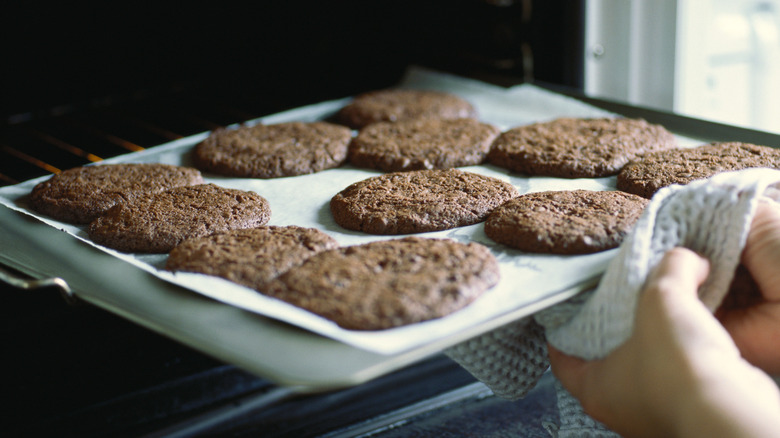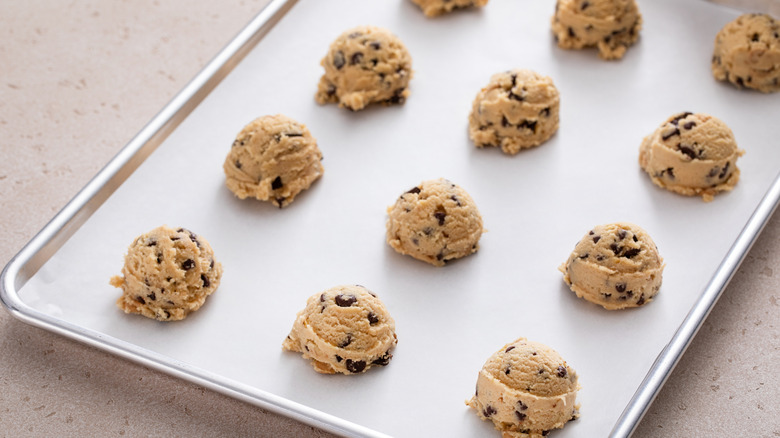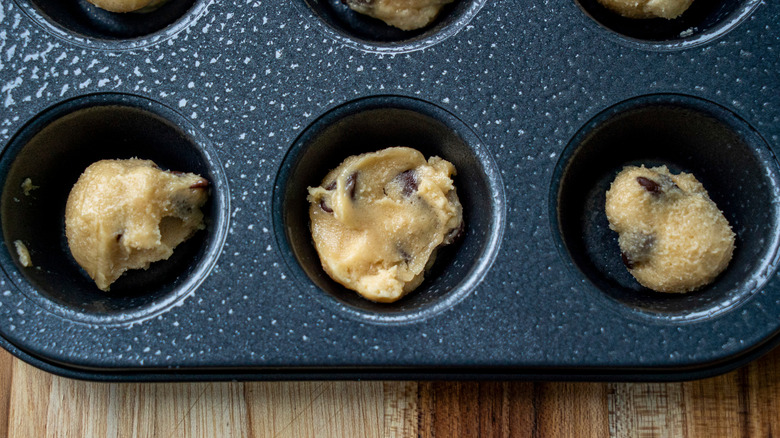You Can Stop Cookies From Spreading In The Oven, But You Have To Act Fast
As you peek through the oven window, it can be disappointing to see that your cookies are spreading into puddles after you spent time precisely measuring the ingredients and carefully mixing your dough. It may appear like a total failure, but you have time to save the batch if you act quickly.
As soon as you notice a spreading issue, remove the cookies from the oven so that you can reshape and separate them while they're still hot and malleable. You can use practically anything except for your fingers (the dough and pan will be hot) to push the edges of the cookies into the desired shape: A spoon or the tip of a paring knife will work nicely. Alternatively, place a slightly larger cookie cutter or jar lid around each hot cookie, and swirl it quickly so that the sides nudge inward. When you're done making the cookie smaller around, place the baking sheet back in the oven to finish baking.
This trick works if your cookies are fully baked, too, because cookies don't fully set until they cool off. If you already used this hack once while baking, you can do it a second time when the cookies are done. Just whip them into shape out of the oven, and allow them to cool as usual afterward.
Recipe adjustments that prevent cookie spreading
If your cookies spread too much in the oven every time you make them, consider adjusting your recipe. The sugar ratio, for instance, has an impact on what happens to your cookies during baking. Since sugar absorbs liquid, reducing the amount that you add by 10% will allow the flour to draw in more of the moisture so that the dough spreads less and stiffens more.
Also, the type of fat you use has a huge effect on how much cookies spread in the oven. Although most recipes call for butter, it has a low melting point and results in wider and thinner cookies. Substitute up to half of the butter for the same amount of shortening, which has a high melting point and will help your cookies maintain a thicker shape.
When you don't have shortening on hand or just prefer to use only butter, not chilling the dough before baking it is a mistake that ruins cookies and leads to spreading. Sticking your dough in the refrigerator for a few hours beforehand keeps the butter cold so that it takes longer to melt in the oven. If you're in a hurry, speed up the chilling process by using the ice bath hack to prevent cookies from spreading.
More preventive measures to stop cookies from spreading
Aside from adjusting your recipe, you can take other steps to prevent cookie spreading. Before chilling the dough, use an ice cream scoop like Martha Stewart recommends to create tall, thick drops of cookies on your cookie sheet. Then, you don't have to worry about rolling stiff dough into balls or your hands warming up the dough again before you put it in the oven.
Also, not using quality cookie sheets is one of the most common baking sheet mistakes that people make. Since the metal thickness and color will affect the cookie spread, choose a light-colored one with low sides. The thinner and darker the sheets are, the hotter that they will get, which means that your cookies will turn out thinner and overbaked.
Similarly, you should never use a hot baking sheet for cookie dough because the dough will start warming up before you get it into the oven. If you don't have multiple cookie sheets to rotate between batches, completely cool yours in the freezer or under cold water before reusing it.
Also, skip greasing the pan – the extra fat will encourage the dough to spread. Instead, parchment paper for baking has a nonstick coating without being too slippery or adding extra fat to your dough. To control the size of your cookies even further, use the muffin tin hack to stop cookies from spreading.


